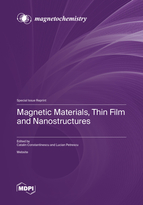Magnetic Materials, Thin Films and Nanostructures
A special issue of Magnetochemistry (ISSN 2312-7481). This special issue belongs to the section "Magnetic Materials".
Deadline for manuscript submissions: closed (31 May 2023) | Viewed by 26822
Special Issue Editors
Interests: material science; laser and plasma processing; thin films; nanomaterials; surface structuring
Special Issues, Collections and Topics in MDPI journals
Interests: magnetic materials; magnetic hysteresis; electromagnetic field computation; planar transformers; power transformers
Special Issues, Collections and Topics in MDPI journals
Special Issue Information
Dear Colleagues,
In this Special Issue, the aim is to cover all relevant aspects of chemical and physical processes of the production and characterization of magnetic materials in bulk, thin films, nanostructures and/or nanocomposites, as well as modeling aspects involving such structures.
Accordingly, this Special Issue welcomes original research and review manuscripts on the challenges and trends covering fundamental and experimental research—with special focus on the design, synthesis, and characterization of any type of magnetic material and the study of its structure/property relationships. We also welcome manuscripts on the development of new experimental concepts, to the transfer, chemical transformation, high-resolution patterning of advanced thin films and nanomaterials, to the design and fabrication of devices.
Magnetic Materials, Thin Films and Nanostructures (Volume II) (https://www.mdpi.com/journal/magnetochemistry/special_issues/M35N4HH7Y8) has been set up. Your new submissions are welcome to submit to Volume II (https://www.mdpi.com/journal/magnetochemistry/special_issues/M35N4HH7Y8).
Dr. Catalin Constantinescu
Dr. Lucian Petrescu
Guest Editors
Manuscript Submission Information
Manuscripts should be submitted online at www.mdpi.com by registering and logging in to this website. Once you are registered, click here to go to the submission form. Manuscripts can be submitted until the deadline. All submissions that pass pre-check are peer-reviewed. Accepted papers will be published continuously in the journal (as soon as accepted) and will be listed together on the special issue website. Research articles, review articles as well as short communications are invited. For planned papers, a title and short abstract (about 100 words) can be sent to the Editorial Office for announcement on this website.
Submitted manuscripts should not have been published previously, nor be under consideration for publication elsewhere (except conference proceedings papers). All manuscripts are thoroughly refereed through a single-blind peer-review process. A guide for authors and other relevant information for submission of manuscripts is available on the Instructions for Authors page. Magnetochemistry is an international peer-reviewed open access monthly journal published by MDPI.
Please visit the Instructions for Authors page before submitting a manuscript. The Article Processing Charge (APC) for publication in this open access journal is 2700 CHF (Swiss Francs). Submitted papers should be well formatted and use good English. Authors may use MDPI's English editing service prior to publication or during author revisions.
Keywords
- engineering/processing of magnetic materials, nanomaterials/nanostructures and thin films
- characterization of magnetic materials, nanomaterials/nanostructures and thin films
- theoretical models and calculations of magnetic materials
- applications of magnetic materials







